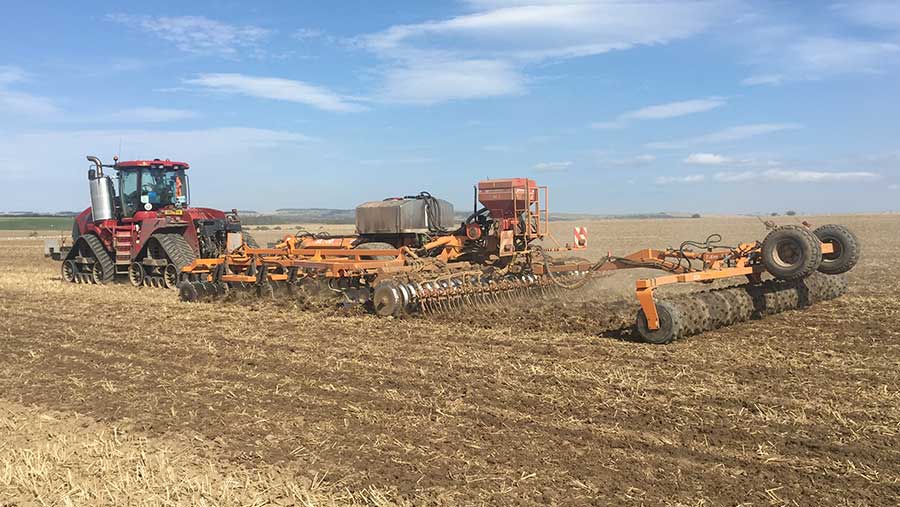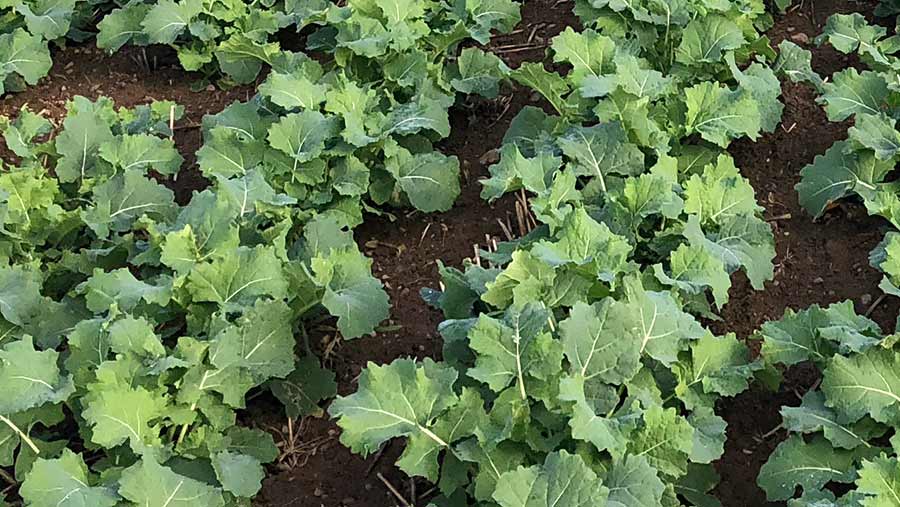How two top oilseed rape growers achieve high yields

Two leading Scottish Borders oilseed rape growers’ focus on crop establishment and nutrition has led them to push their average farm yields towards the 5t/ha barrier.
David Fuller manages 650ha of rapeseed, while David Fuller-Shapcott has just 17ha in the ground, but both have similar approaches to getting the best out of their crops.
Both adopt single-pass crop establishment systems to conserve soil moisture and are exploring timings and rates of micronutrient applications to push yields past 5t/ha.
Mr Fuller manages 3,300ha of arable land for McGregor Farms based at Coldstream, on both sides of the border, while Mr Fuller-Shapcott farms 400ha of higher and heavier land just north of Kelso.
See also: High oilseed yields come from keeping crops growing longer
David Fuller, McGregor Farms, Coldstream Mains

David Fuller
Farms 3,300ha of arable land including the home farm and 14 contract farms, including 650ha of oilseed rape in a one-in-four-year rotation.
Soils are a range of medium sandy clay. The five-year average oilseed rape yield is 4.75t/ha and the highest yielding field ever was in 2011 at 6.24t/ha.
David Fuller-Shapcott, Sweethope Farm, Kelso

David Fuller-Shapcott
Farms 400ha of largely arable land including normally 55ha of oilseed rape, but for rotational reasons is only 17ha this season.
Soils are heavy and run up to nearly 200m in altitude. The five-year average oilseed rape yield is 4.36t/ha and the highest-ever yield was 5.6t/ha.
Yield competition
Both have entered the Yield Enhancement Network (YEN) competition organised by the crop consultant Adas to find top-yielding crops of oilseed rape in the two years of 2017 and 2018 in which the competition has been conducted.
The plant breeder Dekalb, sponsored eight growers last season – six from the UK and two from Denmark – including these two from the Scottish Borders, out of a total YEN entry of 62 growers in 2018 when the average yield was 4.7t/ha.
Adas has identified that top yields come from harvested crops of over 100,000 seeds/sq m, and Lincolnshire grower Tim Lamyman won the 2018 YEN with a crop that yielded 6.4t/ha, producing nearly 160,000 seeds/sq m.
The Scottish Borders can be top oilseed rape growing territory, with good soils, not excessive rainfall and generally cool summers that can give long periods for pod filling, while largely escaping from cabbage stem flea beetle damage.
But this northern area does face challenges, with the need for early drilling ahead of short autumns and control of yield-damaging light leaf spot disease.
Crop establishment

David Fuller’s early crop
Mr Fuller uses a two 7m-wide Simba SL machines combining discs, 200mm deep tines, drill and roller, which also applies liquid fertiliser in front of the seed, and preferably drills straight into chopped wheat straw in 450mm-row widths.
“We are aiming to retain moisture and also improve drainage, and are drilling 40 seeds/sq m to give us 25 plants in March,” he says.
His 650ha of oilseed rape can be drilled in 10 days with the two machines, but that leaves a tight window between wheat harvest and his preferred cut off drilling date of end-August, which can be extended to 5 September in difficult seasons.
He is constantly looking for more accurate seed placement and ideally would like to precision drill as low as 30-35 seeds/sq m if the cost of precision drilling were not prohibitive.
Mr Fuller-Shapcott follows a similar approach on a smaller scale with a 3m-wide one-pass machine consisting of a combination of 200mm tines, discs and rollers with solid fertiliser added, and then rolled at 30 degrees to the drilling.
For him, with land rising up to 200m the crop must follow early-maturing winter barley and preferably be drilled between 15 and 23 August into warm soil using 432mm row widths.
“We are looking for big bushy plants and not Christmas trees, and early drilling is essential as our heavy soils can go cold very quickly,” he adds.
Low seed rates
Both are adamant about low seed rates and hence low plant numbers, with Mr Fuller saying: “Oilseed rape plants do not like their neighbours,” while Mr Fuller-Shapcott is looking for large single plants and not “a field a cress”.
Will Vaughan-France, technical specialist at the rapeseed breeder Dekalb, now part of Bayer, says growers of hybrid varieties should be going into the winter with 20-30 plants/sq m.
Both growers use hybrid varieties because of their good vigour – especially useful in the short autumns in these northern climes – but have different requirements depending on soil type and altitude.
Mr Fuller is 100% hybrid across his 650ha as he is looking for good vigour in the autumn and also in the early spring allied with a consistent performance.
He is picking varieties based on high oil content, light leaf spot and phoma resistance, pod shatter resistance and high stem strength, and interestingly not out-and-out yield.
This year half his area is in Expansion, with other big varieties being Exclaim and Exalte, which Mr Fuller says tick all his requirements, with especially good autumn vigour that is important as temperatures and day lengths fall quickly in the autumn.
Spring vigour
Mr Fuller-Shapcott has a subtly different approach in that he is looking for spring vigour, but not earliness of growth. So he favours Exclaim, while also looking for good oil content, disease resistance and standing ability of his hybrid varieties.
“I don’t want my crops growing too early in the spring when I can not get out on my heavy land,” he says.
He is not too concerned about his crops having a birthday as his 2018 YEN crop, yielding 4.9t/ha, was drilled on 19 August and harvested the next year on 29 August.
Mr Fuller emphasised the importance of good light leaf spot resistance of 6-plus where 9 is good resistance and 1 poor, as it is not often possible to spray fungicides between mid-November and mid-stem extension in the spring.
Crop nutrition
Both growers were applying about 200kg/ha of nitrogen on their YEN crops last year with generous applications of sulphur, but their attention is moving to other plant nutrients.
Mr Fuller is keen to top up his crop with phosphate in the spring to improve rooting, while Mr Fuller-Shapcott is applying foliar phosphate at flowering and post-flowering as phosphate is often locked up in his heavy soils.
“Plants will not get phosphate out of our soils but the crop desperately needs it,” he says.
Both are conducting tissue testing – with attention focusing on boron, magnesium and molybdenum – and looking at timing and application rates.
“We are looking at the best application times for micronutrients, using historical information to see if we get any rooting improvement,” says Mr Fuller.
YEN oilseed rape crops for harvest 2018 |
||
| David Fuller, McGregor Farms, Coldstream Mains | David Fuller-Shapcott, Sweethope Farm | |
| Variety | Exalte | Exclaim |
| Yield | 5.5t/ha | 4.9t/ha |
| Yield potential | 47% of 11.7t/ha | 44% of 11.1t/ha |
| Previous crop | Winter barley | Winter barley |
| Establishment | One-pass system | One-pass system |
| Sowing date | 24 August | 19 August |
| Seed rate | 40 seeds/sq m | 30 seeds/sq m |
| Plant population | 27 plants/sq m | 23 plants/sq m |
| Total nitrogen applied | 200kg/ha | 200kg/ha |
| Harvest date | 5 August | 29 August |
| Harvest seed numbers | 99,000 seeds/sq m | 88,355 seeds/sq m |
